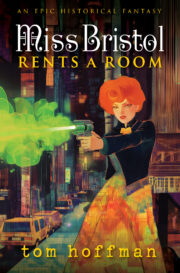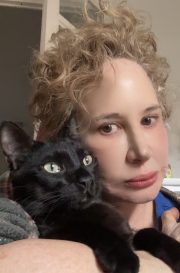Making Soft Magic Systems Work
by M.K. Hutchins
 Soft magic has been with us since humans had stories: it’s in our fairytales, our folklore, and continues to be popular today, appearing in everything from Studio Ghibli films to the writings of Terry Pratchett, to Axie Oh’s The Girl Who Fell Beneath the Sea. Soft magic usually gets defined by what it isn’t: hard magic, or magic where the rules are so clear, it functions like a fantastical science.
Soft magic has been with us since humans had stories: it’s in our fairytales, our folklore, and continues to be popular today, appearing in everything from Studio Ghibli films to the writings of Terry Pratchett, to Axie Oh’s The Girl Who Fell Beneath the Sea. Soft magic usually gets defined by what it isn’t: hard magic, or magic where the rules are so clear, it functions like a fantastical science.
But “soft” and “hard” isn’t a strict black-and-white difference. I think of magic systems like cheeses: some are parmesan, some are brie, and there’s a lot of semi-soft cheddar and manchego in between. I’ve seen soft magic systems maligned as merely broken hard magic systems, but I strongly believe that all cheeses are good cheeses. If we judge brie by how well it grates, we will always be disappointed.
In his essay, “Sanderson’s First Law,” Brandon Sanderson outlines how hard magic, because it has clear rules, can be used in clever and interesting ways to solve plot problems. Much ink has been spilled on how to make this kind of magic function in a story. But how do soft magic systems function? What makes good brie?
Some have argued that soft magic only exists to provide a sense of wonder, but if that were true, everyone would write and read hard magic books—which also have amazing settings. Rather, I posit that soft magic allows the writer to show what the problems are in an interesting fashion.
Disney’s Encanto is a masterclass in soft magic. There are very few rules: the Madrigals have a magic house and every child in the family Madrigal gets a magical ability when they turn five. The problem? This family is fracturing under the weight of intergenerational trauma. Louisa’s super strength allows us to see how much pressure she is under to be strong, both physically and mentally. Isabela’s flower-growing demonstrates her perfectionism and gives us a deeply satisfying visual when she lets go of it. Antonio doesn’t have any apparent problems, but his flashy, entertaining gift of speaking to animals shows how rejected and ignored the giftless Mirabel is.
Magic can’t save the family Madrigal. Rather, the magic shows us how they’re hurting.
In The Hobbit, the otherworldly Arkenstone is the problem made tangible. The Arkenstone isn’t merely treasure: it is treasure for treasure’s sake, wealth without purpose. In a story where the people of Laketown need resources to rebuild, the Arkenstone allows Tolkien to differentiate between needs, wants, comforts, and dragonish greed.
Bilbo spends the entire book gaining the friendship and respect of the dwarves and then does something rather radical: He steals and gives away the Arkenstone in an attempt to avoid war. In the end, the dying leader of the dwarves tells Bilbo he had the right of things: “If more of us valued food and cheer and song above hoarded gold, it would be a merrier world.”
Soft magic systems can run into two major pitfalls. One is being too on the nose. The Hobbit could have felt like an allegory, but Bilbo’s many adventures and detailed worldbuilding avoid this. Middle-earth feels like a world full of stories, rather than a story with a world pasted in around it.
Secondly, the mechanical solutions that work so well in hard magic systems usually feel cheap, random, or overpowered in soft magic systems. In Encanto, Bruno suggests Mirabel hug her sister to fix the family’s haywire gifts. If that had worked, it would have been terrible. A single hug does not repair a hurting family. Instead, when Mirabel approaches her sister for a hug, they argue, fight, actually talk to each other, and come to understand each other better. They make hard-earned progress toward a better relationship—which in turn makes for a satisfying stepping stone toward the climax.
Many soft magic stories avoid the possibility of a cheap-feeling, mechanical solution by starring unmagical protagonists—but it’s not required. My Little Pony: Friendship is Magic features powerful magic users, but the magic either only works after they’ve figured out the underlying problems, or the magic just highlights and defines the problems (a normal pony can only freak out so much about their homework; Twilight Sparkle can throw all of Ponyville into chaos).
Many fantasy stories land somewhere between soft and hard systems—and a single book can have both at the same time. I usually think of Brandon Sanderson as the Parmigiano Reggiano of fantasy, but there’s a soft magic system embedded in the hard magic of The Stormlight Archives. The Knights Radiant level up in their order not when they’ve practiced enough or obtained a mystical macguffin: They have to do the internal work to say an oath and mean those words on the inside. This is a magic system full of rules that, indeed, get used in very interesting ways. It’s also a magic system where character growth (or a lack thereof) is visibly externalized through oaths. This could feel like a cheap power-up, but Sanderson makes his characters deal with their inner problems, leading to powerful character moments instead.
Soft magic systems often display internal and interpersonal conflicts—and I think that’s why they resonate with us. When we grow as people, when we make or repair a friendship…that feels like magic. As I’ve watched friends tell hard truths and fight personal demons, I’ve thought, If we lived in a better world, they’d absolutely be able to fly by now.
There’s no strict divide between hard and soft magic. You can have both. But when writing, I find it useful to ask myself—what role does magic play in this story? What mechanics need to be clear for the plot to be satisfying? What emotions and character arcs is the magic highlighting? Thinking about the different ways hard and soft magic systems work—solving problems versus demonstrating them—helps me figure out how to craft a better story, whatever kind of cheese I’m working with.
 M.K. Hutchins often draws on her background in archaeology when writing fantasy and science fiction. She’s the author of several novels, including Ana’s Asteroid and The Redwood Palace, along with over thirty short stories appearing in Podcastle, Analog, Strange Horizons, and elsewhere. When not writing, she’s usually with her children as they grow veggies, bake, read books, and play board games together, though not usually all at the same time. Find her at https://linktr.ee/mkhutchins.
M.K. Hutchins often draws on her background in archaeology when writing fantasy and science fiction. She’s the author of several novels, including Ana’s Asteroid and The Redwood Palace, along with over thirty short stories appearing in Podcastle, Analog, Strange Horizons, and elsewhere. When not writing, she’s usually with her children as they grow veggies, bake, read books, and play board games together, though not usually all at the same time. Find her at https://linktr.ee/mkhutchins.


